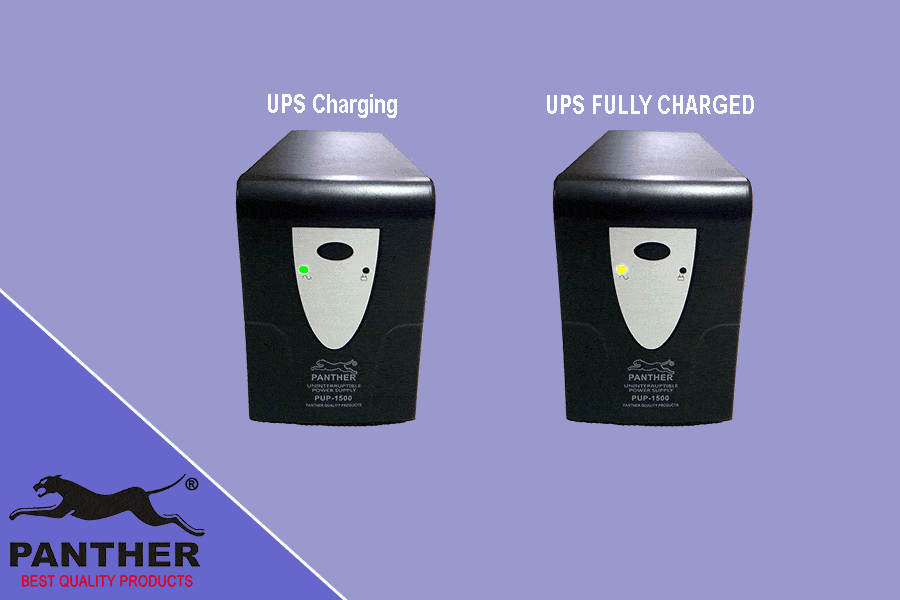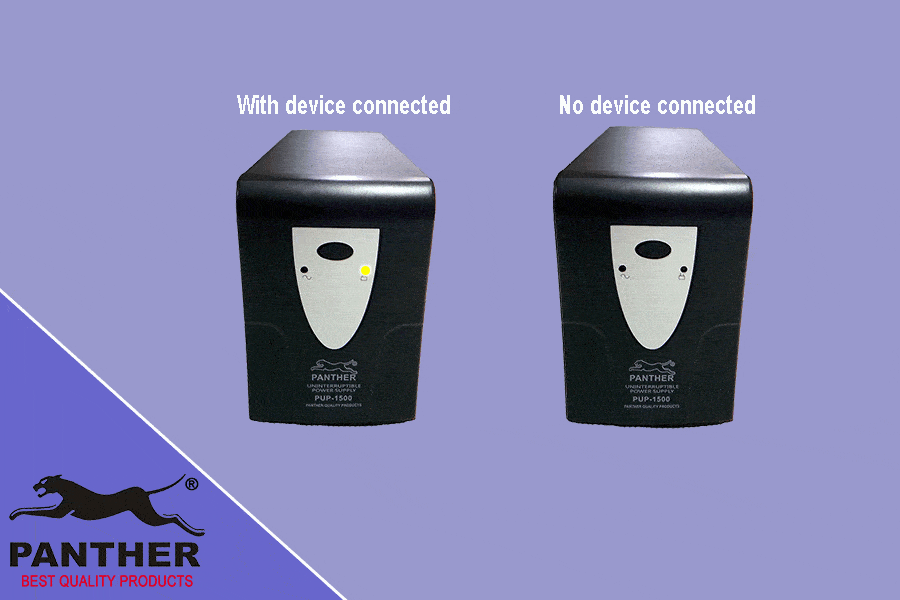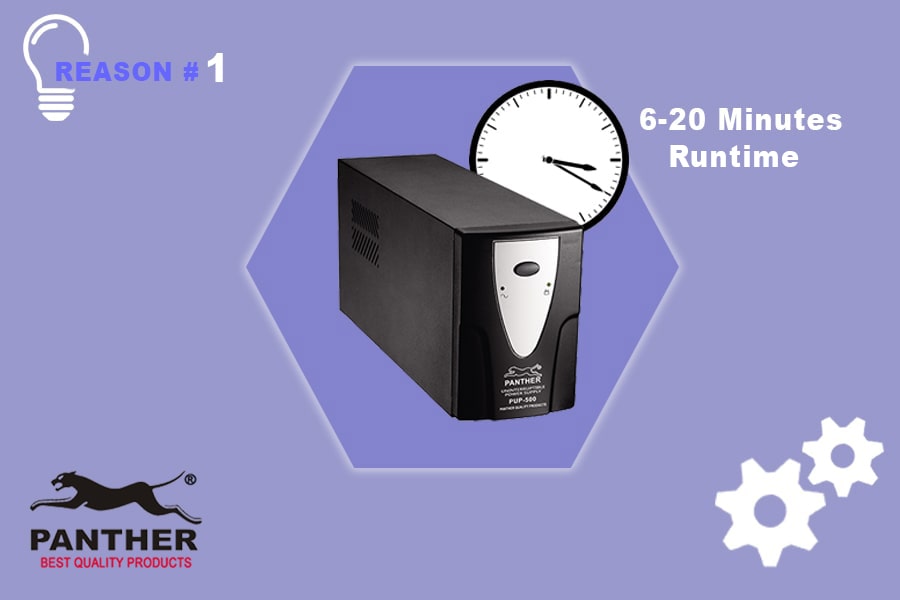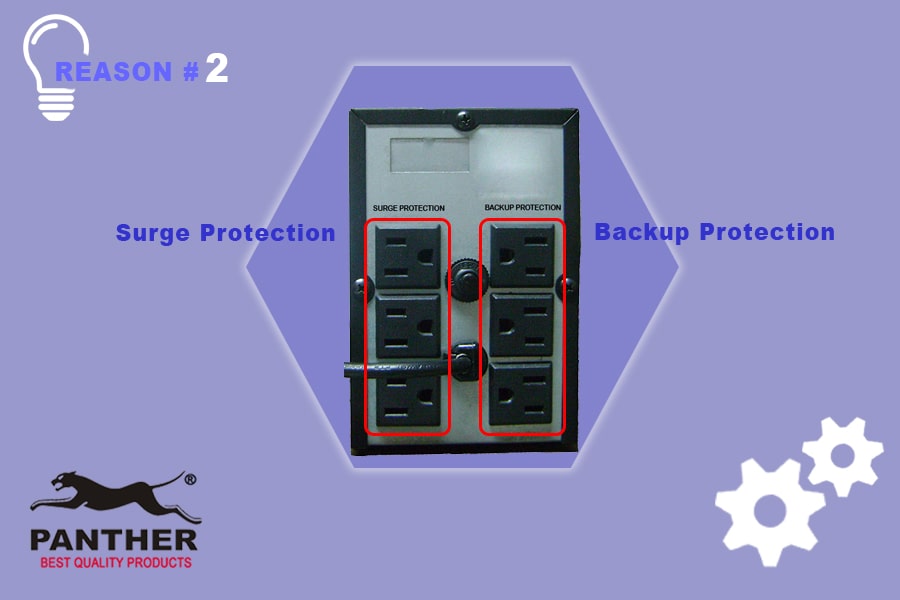
Table of Contents
- How do I set up my Panther UPS?
- How will I know if my UPS is powered on?
- How do I charge my UPS battery?
- How will I know if the UPS battery is still charging or fully charged? Why is there a blinking yellow light on my UPS?
- Why do I hear a beeping sound or why is there a blinking yellow light on my UPS?
- How will I know if my UPS is low on battery?
- A power outage occurred, but the equipment I plugged into the UPS did not stay on. What’s the problem?
- How do I know if it’s time to change my UPS battery?
- My Panther UPS (PUP) concern is not covered by this article, what do I do?
Bought a Panther Uninterruptible Power Supply and now it’s acting up? Don’t panic. We’re here to help you troubleshoot. For your reference, please see the illustrative diagram below, which indicates the different parts of your Panther Uninterruptible Power Supply (PUP) unit.

Below, we have collated the common questions posed to us by customers. Kindly check to see if your experience can be found here.
How do I set up my Panther UPS?
The Panther UPS is incredibly easy to set-up – simply plug and use!
- Step 1: Plug in the UPS into a verified grounded 3-wire wall outlet.
- Step 2: Fully charge the UPS battery for 10-12 hours before use
- Step 3: Connect your equipment to the BACKUP outlets
- Step 4: Switch on the UPS by pressing the power switch
For more detailed instructions, check out this step-by-step guide.
How will I know if my UPS is powered on?
On the front panel of the Panther UPS unit, long press the power switch until you feel a ‘click’ under your finger and the UPS turns on.
- If both yellow and orange LED lights are not lit, unit is OFF. Press the power switch until the unit turns on
- If yellow LED light is lit, unit is ON and in AC mode (meaning it draws power from the wall outlet)
- If orange LED light is lit, unit is ON and in Battery mode (meaning it draws back-up power from the PUP battery)

How do I charge my UPS battery?
Upon plugging your Panther UPS to the wall outlet, it will automatically enter a charging state since it is connected to AC power (wall outlet). For initial charging, do not plug any equipment to the UPS, and keep it plugged in for ~10-12 hours to achieve full charge.

How will I know if the UPS battery is still charging or fully charged? Why is there a blinking yellow light on my UPS?
If you see a blinking green light, this is an indication that your UPS is charging. After awhile, you will notice that the blinking rate gradually slows down until it become steady.
Once fully charged, the LED will become a steady yellow, this means your UPS is now fully charged. Fully charging the UPS can take up to 10-12 hours depending on how depleted your UPS battery was originally.

Why do I hear a beeping sound or why is there a blinking yellow light on my UPS?
The beeping sound and yellow light serves as an alarm. It tells you your UPS is currently on battery mode, meaning it is consuming UPS battery power as opposed to drawing power from the wall outlet.
Typically, this should occur during a power outage. As such, when you hear this, that’s your cue to start saving your documents and properly shut down plugged-in equipment.
Note: If there are no device plugged into the UPS, the UPS will automatically shut down after 1-2 minutes to conserve battery power.
However, if there is no power outage, yet the UPS is on battery mode, kindly check and make sure the UPS is plugged securely to the wall outlet. Otherwise, kindly bring in your UPS for a diagnostic check up and/or servicing.
How will I know if my UPS is low on battery?
When the UPS is low on battery, the yellow LED will blink twice when there is a device connected and blink once if no device is connected. Kindly charge your UPS immediately when this occurs by plugging the UPS into a power outlet.

A power outage occurred, but the equipment I plugged into the UPS did not stay on. What’s the problem?
There could be multiple reasons for this, so please check below options to see if the following applies to you:
Reason #1: The equipment only stayed on for a few seconds or minutes, but shut off afterwards.
Answer: The Panther UPS’s runtime (amount of time the UPS battery can power the plugged in equipment) is ~6-20 minutes. This is dependent on the battery condition at the time of the power outage, and the amount of power being consumed by the equipment plugged into the UPS.

Reason #2: The UPS stayed on, but the equipment did not.
Answer: Kindly check if your equipment is plugged into the Back-Up outlets because only these outlets are UPS and AVR-protected.

Reminder: The Surge Protection outlets of the UPS acts purely as an extension cord with voltage surge protection only.
Reason #3: The UPS is low on battery.
Answer: You will know the UPS is low on battery when the yellow LED will blink twice when there is a device connected and blink once if no device is connected. If so, please unplug all equipment connected to the UPS, then fully charge your UPS for ~10-12 hours by plugging it into a working power outlet.

Reason #4: The power requirements of the equipment plugged into the UPS far exceeds the rated capacity of the UPS.
Answer: You can identify if this is the case by checking the circuit breaker (found at the back panel of the UPS) to see if it has been tripped due to overload. When tripped, the circuit breaker will rise up slightly, and you will experience resistance when pushing the circuit breaker to reset.
Note: please do NOT connect laser printers and plotters to the UPS as they draw a significant amount of power even when idle. You can also opt to calculate the power requirements of your equipment by following these step-by-step instructions (article on how to calculate capacity requirements).

After resetting the UPS, fully charge the UPS for 10-12 hours. Once done, test the UPS backup power by unplugging all devices connected to it, then unplugging the UPS from the power outlet. The UPS should stay on for ~1-2 minutes before turning off automatically to conserve battery power (since no device is connected to it)

Reason #5: The UPS may be in need of servicing, e.g. due to a blown fuse, a battery issue, etc.
Answer: Kindly bring in your UPS for servicing, as part of Panther’s Lifetime Service Warranty, so that the issue can be diagnosed by a licensed technician.

How do I know if it’s time to change my UPS battery?
The average life of a UPS battery is ~2 years, however this can be shorter or longer depending on how well-maintained the battery is as well as how often it’s used (e.g. more power outages = more usage). When the battery is no longer maintaining its charge, then it’s an indicator to replace the UPS battery.
Sample indicator: After fully charging for 10-12 hours, the UPS is still low on battery, as evidenced by the blinking yellow light on the unit.

My Panther UPS (PUP) concern is not covered by this article, what do I do?
Kindly take a video of your Panther UPS showing the issue you are concerned about. Please then email the video to wecare.panther@gmail.com, indicating the following information:
- Issue experienced
- Circumstances when this issue occurs
- Serial Number of Panther item
- When and where item was purchased
- Name and contact number (so our Customer Service Representative can reach out to you)
Expect our Customer Service Representative to get back to you within ~1-2 working days.




My UPS green/yellow led blinks and beeps fast at the same time. What could be the reason this is happening? I plugged it to charge but after roughly 2hrs the said condition occur. For now i disconnect and keep it stand-by.What shall i do? Thanks
Good day! Our Customer Service Representative will reach out to you via email to better understand the situation and provide next steps.
Good Day!
Our UPS keeps beeping very fast, what is seems to be the problem?
Good day! Could you send us a video of your UPS exhibiting this issue to wecare.panther@gmail.com (our Customer Service Center)? We can then conduct an audio-visual assessment based on that. We look forward to hearing from you!
Hi my ups beeps fast. Its working smoothly but its annoying. Sometimes the beep sound is not present but most of the time it comes back
Good day! Kindly check and make sure the power cord is secured firmly to the outlet, as it might be loose resulting in battery mode from time-to-time. If the issue still persists, kindly take a video of the set-up and send to wecare.panther@gmail so we can conduct an audio-visual assessment. We hope this helps!
My PUP-500 makes a clicking noise
Good day! When you say clicking sound – would this be similar to the beeping sound you’d hear when the UPS is unplugged from a power supply (on battery mode)? If yes, kindly check if the UPS is plugged securely to the wall outlet, and make sure there is power in said wall outlet.
Another possible cause of the clicking sound could be coming from the AVR’s relay, which is normal, as this sound is generated when voltage is being regulated.
Alternatively, kindly take a video of the PUP 500 making the clicking sound, as well as your current UPS set-up and send to wecare.panther@gmail.com , so we can help conduct an initial audio-visual diagnosis.
We hope this helps!